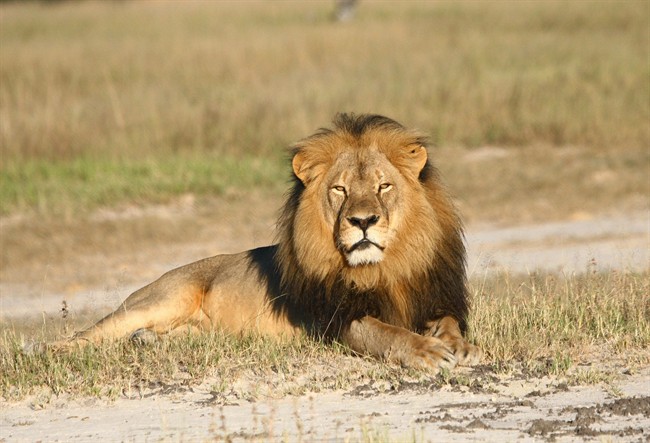The son of Cecil the lion — whose 2015 killing prompted international outcry — has been shot dead during a hunt.

Six-year-old Xanda was killed during a “legal trophy hunt” on July 7, outside Zimbabwe’s Hwange National Park.
The news was confirmed Thursday on Facebook by group Friends of Hwange Trust.
READ MORE: African trophy hunting trade show protest in downtown Saskatoon
“How terribly sad to lose another pride male in his prime,” read the Facebook post. “We’re so sorry to have to spoil everyone’s day with this news.”
Xanda was identified by Oxford University researchers, who have been studying the area’s lions for years, and had installed a GPS tracking collar on him.
WATCH: Dentist who killed Cecil the lion returns to work
“Xanda was one of these gorgeous Kalahari lions, with a big mane, big body, beautiful condition — a very, very lovely animal,” Andrew Loveridge of Oxford’s research group told The Guardian.
The lion was reportedly killed by a Zimbabwean professional hunter during a trophy hunt organized by Richard Cooke. Cooke killed Xanda’s brother in 2015, according to a Facebook page called Lions of Hwange National Park.
READ MORE: African reserve where Cecil the lion lived may have to kill 200 lions due to overpopulation
Xanda’s death comes just two years after Minnesota dentist Walter Palmer killed Cecil. Zimbabwe described the killing as illegal and said it would charge Palmer, but later dropped that plan.
Hwange National Park is home to about 450 lions. According to conservative group Panthera, Africa’s lion population has been declining for years, and is currently around 20,000. The species is classified as “critically endangered” in West Africa.
— With files from The Associated Press
- 16-year-old child of billionaire tech CEO reported missing
- U.S. tourist faces 12-year sentence for bringing ammo to Turks and Caicos
- Canada refused to repatriate woman from ISIS camp because she can’t be arrested: internal memo
- Bombardier, Airbus get exemptions from Canadian sanctions on Russian titanium




Comments